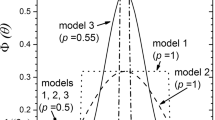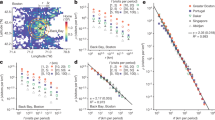Abstract
Human mobility and activity patterns mediate contagion on many levels, including the spatial spread of infectious diseases, diffusion of rumours, and emergence of consensus. These patterns however are often dominated by specific locations and recurrent flows and poorly modelled by the random diffusive dynamics generally used to study them. Here we develop a theoretical framework to analyse contagion within a network of locations where individuals recall their geographic origins. We find a phase transition between a regime in which the contagion affects a large fraction of the system and one in which only a small fraction is affected. This transition cannot be uncovered by continuous deterministic models because of the stochastic features of the contagion process and defines an invasion threshold that depends on mobility parameters, providing guidance for controlling contagion spread by constraining mobility processes. We recover the threshold behaviour by analysing diffusion processes mediated by real human commuting data.
This is a preview of subscription content, access via your institution
Access options
Subscribe to this journal
Receive 12 print issues and online access
$209.00 per year
only $17.42 per issue
Buy this article
- Purchase on Springer Link
- Instant access to full article PDF
Prices may be subject to local taxes which are calculated during checkout




Similar content being viewed by others
References
Marro, J. & Dickman, R. Nonequilibrium Phase Transitions in Lattice Models (Cambridge Univ. Press, 1999).
van Kampen, N. G. Stochastic Processes in Physics and Chemistry (North-Holland, 1981).
May, R. M. & Anderson, R. M. Spatial heterogeneity and the design of immunization programs. Math. Biosci. 72, 83–111 (1984).
Bolker, B. M. & Grenfell, T. Chaos and biological complexity in measles dynamics. Proc. R. Soc. Lond. B 251, 75–81 (1993).
Bolker, B. M. & Grenfell, T. Space persistence and dynamics of measles epidemics. Phil. Trans. R. Soc. Lond. B 348, 309–320 (1995).
Sattenspiel, L. & Dietz, K. A structured epidemic model incorporating geographic mobility among regions. Math. Biosci. 128, 71–91 (1995).
Lloyd, A. L. & May, R. M. Spatial heterogeneity in epidemic models. J. Theor. Biol. 179, 1–11 (1996).
Keeling, M. J. & Rohani, P. Estimating spatial coupling in epidemiological systems: A mechanistic approach. Ecol. Lett. 5, 20–29 (2002).
Watts, D., Muhamad, R., Medina, D. C. & Dodds, P. S. Multiscale resurgent epidemics in a hierarchical metapopulation model. Proc. Natl Acad. Sci. USA 102, 11157–11162 (2005).
Rapoport, A. Spread of information through a population with socio-structural bias: I. Assumption of transitivity. Bull. Math. Biol. 15, 523–533 (1953).
Goffman, W. & Newill, V. A. Generalization of epidemic theory: An application to the transmission of ideas. Nature 204, 225–228 (1964).
Goffman, W. Mathematical approach to the spread of scientific ideas—the history of mast cell research. Nature 212, 449–452 (1966).
Dietz, K. Epidemics and rumours: A survey. J. R. Stat. Soc. A 130, 505–528 (1967).
Tabah, A. N. Literature dynamics: Studies on growth, diffusion, and epidemics. Annu. Rev. Inform. Sci. Technol. 34, 249–286 (1999).
Daley, D. J. & Gani, J. Epidemic Modeling: An Introduction (Cambridge Univ. Press, 2000).
Rvachev, L. A. & Longini, I. M. A mathematical model for the global spread of influenza. Math. Biosci. 75, 3–22 (1985).
Grais, R. F., Hugh Ellis, J. & Glass, G. E. Assessing the impact of airline travel on the geographic spread of pandemic influenza. Eur. J. Epidemiol. 18, 1065–1072 (2003).
Hufnagel, L., Brockmann, D. & Geisel, T. Forecast and control of epidemics in a globalized world. Proc. Natl Acad. Sci. USA 101, 15124–15129 (2004).
Colizza, V., Barrat, A., Barthélemy, M. & Vespignani, A. The role of the airline transportation network in the prediction and predictability of global epidemics. Proc. Natl Acad. Sci. USA 103, 2015–2020 (2006).
Balcan, D. et al. Modeling the spatial spread of infectious diseases: The GLobal Epidemic and Mobility computational model. J. Comput. Sci. 1, 132–145 (2010).
Chowell, G., Hyman, J. M., Eubank, S. & Castillo-Chavez, C. Scaling laws for the movement of people between locations in a large city. Phys. Rev. E 68, 066102 (2003).
Barrat, A., Barthélemy, M., Pastor-Satorras, R. & Vespignani, A. The architecture of complex weighted networks. Proc. Natl Acad. Sci. USA 101, 3747–3752 (2004).
Guimerá, R., Mossa, S., Turtschi, A. & Amaral, L. A. N. The worldwide air transportation network: Anomalous centrality, community structure, and cities’ global roles. Proc. Natl Acad. Sci. USA 102, 7794–7799 (2005).
Brockmann, D., Hufnagel, L. & Geisel, T. The scaling laws of human travel. Nature 439, 462–465 (2006).
Patuelli, R., Reggiani, R., Gorman, S. P., Nijkamp, P. & Bade, F-J. Network analysis of commuting flows: A comparative static approach to German data. Netw. Spatial Econ. 7, 315–331 (2007).
González, M. C., Hidalgo, C. A. & Barabási, A-L. Understanding individual human mobility patterns. Nature 453, 779–782 (2008).
Wang, P. & González, M. C. Understanding spatial connectivity of individuals with non-uniform population density. Phil. Trans. R. Soc. A 367, 3321–3329 (2009).
Song, C., Qu, Z., Blumm, N. & Barabási, A-L. Limits of predictability in human mobility. Science 327, 1018–1021 (2010).
Song, C., Koren, T., Wang, P. & Barabási, A-L. Modelling the scaling properties of human mobility. Nature Phys. 6, 818–823 (2010).
Balcan, D. et al. Multiscale mobility networks and the spatial spreading of infectious diseases. Proc. Natl Acad. Sci. USA 106, 21484–21489 (2009).
Colizza, V., Pastor-Satorras, R. & Vespignani, A. Reaction-diffusion processes and metapopulation models in heterogeneous networks. Nature Phys. 3, 276–282 (2007).
Colizza, V. & Vespignani, A. Invasion threshold in heterogeneous metapopulation networks. Phys. Rev. Lett. 99, 148701 (2007).
Colizza, V. & Vespignani, A. Epidemic modelling in metapopulation systems with heterogeneous coupling pattern: Theory and simulations. J. Theor. Biol. 251, 450–467 (2008).
Barthélemy, M., Godrèche, C. & Luck, J-M. Fluctuation effects in metapopulation models: percolation and pandemic threshold. J. Theor. Biol. 267, 554–564 (2010).
Ni, S. & Weng, W. Impact of travel patterns on epidemic dynamics in heterogeneous spatial metapopulation networks. Phys. Rev. E 79, 016111 (2009).
Ben-Zion, Y., Cohena, Y. & Shnerba, N.M. Modeling epidemics dynamics on heterogenous networks. J. Theor. Biol. 264, 197–204 (2010).
Pastor-Satorras, R. & Vespignani, A. Epidemic spreading in scale-free networks. Phys. Rev. Lett. 86, 3200–3203 (2001).
Lloyd, A. L. & May, R. M. How viruses spread among computers and people. Science 292, 1316–1317 (2001).
Cohen, R., Havlin, S. & ben-Avraham, D. Efficient immunization strategies for computer networks and populations. Phys. Rev. Lett. 91, 247901 (2003).
Barrat, A., Barthélemy, M. & Vespignani, A. Dynamical Processes on Complex Networks (Cambridge Univ. Press, 2008).
Keeling, M. J. & Rohani, P. Modeling Infectious Diseases in Humans and Animals (Princeton Univ. Press, 2008).
Ball, F., Mollison, D. & Scalia-Tomba, G. Epidemics with two levels of mixing. Ann. Appl. Probab. 7, 46–89 (1997).
Cross, P., Lloyd-Smith, J. O., Johnson, P. L. F. & Wayne, M. G. Duelling timescales of host movement and disease recovery determine invasion of disease in structured populations. Ecol. Lett. 8, 587–595 (2005).
Cross, P., Johnson, P. L. F., Lloyd-Smith, J. O. & Wayne, M. G. Utility of R0 as a predictor of disease invasion in structured populations. J. R. Soc. Interface 4, 315–324 (2007).
Harris, T. E. The Theory of Branching Processes (Dover, 1989).
Vázquez, A. Polynomial growth in age-dependent branching processes with diverging reproductive number. Phys. Rev. Lett. 96, 038702 (2006).
Molloy, M. & Reed, B. The size of the largest component of a random graph on a fixed degree sequence. Comb. Probab. Comput. 7, 295–306 (1998).
Catanzaro, M., Bogunã, M. & Pastor-Satorras, R. Generation of uncorrelated random scale-free networks. Phys. Rev. E 71, 027103 (2005).
US Census Bureau http://www.census.gov/.
Bailey, N. T. The Mathematical Theory of Infectious Diseases (Macmillan, 1975).
Acknowledgements
We would like to thank to C. Poletto and V. Colizza for interesting discussions during the preparation of this manuscript. This work was partially funded by the NIH R21-DA024259 award and the DTRA-1-0910039 award to A.V.; the work was also partly sponsored by the Army Research Laboratory and was accomplished under Cooperative Agreement Number W911NF-09-2-0053. The views and conclusions contained in this document are those of the authors and should not be interpreted as representing the official policies, either expressed or implied, of the Army Research Laboratory or the US Government.
Author information
Authors and Affiliations
Contributions
D.B. and A.V. conceived and executed the study, performed the analytical calculations and drafted the manuscript. D.B. performed the numerical simulations.
Corresponding author
Ethics declarations
Competing interests
The authors declare no competing financial interests.
Supplementary information
Supplementary Information
Supplementary Information (PDF 265 kb)
Rights and permissions
About this article
Cite this article
Balcan, D., Vespignani, A. Phase transitions in contagion processes mediated by recurrent mobility patterns. Nature Phys 7, 581–586 (2011). https://doi.org/10.1038/nphys1944
Received:
Accepted:
Published:
Issue Date:
DOI: https://doi.org/10.1038/nphys1944



